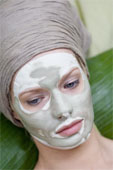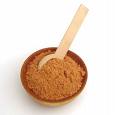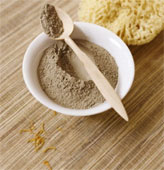Face Packs And Face Masks
Homemade Face Masks For Different Skin Types:

4.Clay And Mud Masks:
The main ingredient in face masks is Mud or Clay. Clay has been used both internally and externally for healing purposes with excellent results for many centuries. Clay is a solid, fat and moist earth that can be red, green, brown, grey, pink, yellow or white. Each type has its own properties which are determined by where it comes from and how deeply it is mined. Clays are naturally occurring, finely ground rocks composed of various minerals. Most clays are deposited from water and found near river banks and deltas or ocean beds. Loess is deposited from airborne dust. Clays are detoxifying and have a “drawing” action due to their electrically charged particles. Traditionally, clay has been used for its healing, detoxifying and germicidal actions.
The colour in Green Clay comes from the 44.5% Silica content which is the most important mineral for the skin. Clay is rich in minerals and active enzymes. Clay treatments stimulate the circulation of blood and lymph, remove dead skin cells and absorb dirt and other surface fats. They also tone and strengthen the connective tissues. Clay stimulates blood circulation and draws toxins and superfluous fat from the skin. It contracts and tones the skin and strengthens the connective tissue. Clay is used for dirty and flaccid skin, acne, for poor blood circulation and to soothe eczema and sunburn.

Types Of Clay Masks:
A.Fuller’s Earth Clay: A sedimentary clay that has been widely used as a skin-lightening agent and is best known for its ability to be applied as a “facial bleach”. Because of its enormous drawing capabilities, Fuller’s Earth is the number one choice for oily skin and those prone to acne, acne problems, blemishes, spotting. It literally draws oil from the skin and has been used industrially for this exact purpose. Also works nicely as a bulk ingredient for skin clay recipes.
B.French Green Clay: French Green Clay (AKA Illite Clay or Sea Clay) has enormous absorbent powers due to the constitution of its micro molecules. It literally “drinks” oils, toxic substances, and impurities from your skin. Its toning action stimulates the skin by bringing fresh blood to damaged skin cells, revitalizing the complexion, and tightening pores. French Green Clay is marvelous for helping to clear problem skin. Use it daily on trouble spots, or weekly as part of a complete facial treatment. Mined from bedrock quarries in France, it is completely natural, unscented and fragrance free.

C.Bentonite Clay: An edible clay from naturally occurring volcanic ash sediments here in the US, a good quality Bentonite should be of a grey/cream color. Traditionally used as an internal supplement to assist in mineral deficiencies, and to help bind toxins making them more soluble. Because of its naturally soft nature it also makes an invigorating skin and facemask. Suitable for food use. Add 2-3 ounces of Bentonite clay to your bath and thoroughly mix in, soak and enjoy. For external packs add one part clay to three parts water or until you reach desired consistency, mix thoroughly to an even paste and apply to skin area.
D.Rhassoul Clay: A truly exquisite Spa quality clay from ancient deposits unearthed from the fertile Atlas mountains of Morocco. Rhassoul is a mineral rich clay that blends extremely well with water making its application to the face and skin a smooth and delightful experience. The best Spas across the globe utilize the toning and enriching benefits offered by Rhassoul and now it’s just as easy to enjoy this splendor within your own home. High in Silica, Magnesium, Iron, Calcium, Potassium and Sodium content, this clay is surely one of the finest treasures for the pampering of your skin.
E.White Kaolin Clay: The most versatile and easily applied clay that is most commonly found in standard skincare preparations and cosmetics. White Cosmetic Clay which is also traded as White Kaolin Clay is a very fine and light clay that has natural absorbency properties and is frequently found in powders, body packs, skin care products, and deodorants.

F.French Pink Clay: Superfine French Pink Clay is a combination of Red and White clay. When using Superfine Pink Clay add purified water, or floral water, mix into a paste and apply to the face or body. Allow to dry, rinse it off, and use your favorite moisturizer to finish. We recommend that you also try adding your preference of essential oils or dried herbs to compliment the mix. Caution to be exercised as clays may stain fabric.
G.French Clay Yellow: Superfine French Yellow Clay obtains its colour from iron oxides and small particles (this clay does not contain aluminum). When using Superfine Yellow Clay add purified water, or floral water, mix into a paste and apply to the face or body. Allow to dry, rinse it off, and use your favorite moisturizer to finish. We recommend that you also try adding your preference of essential oils or dried herbs to compliment the mix. Caution to be exercised as clays may stain fabric.

H.French Clay Red: Superfine French Red Clay comes from Hematite Iron, its colouring the result of the copper oxides contained in this rock. When using Superfine Red Clay add purified water, or floral water, mix into a paste and apply to the face or body. Allow to dry, rinse it off, and use your favorite moisturizer to finish. We recommend that you also try adding your preference of essential oils or dried herbs to compliment the mix. Caution to be exercised as clays may stain fabric.
Clay Masks For Different Skin Types: For sensitive skin the best type of clay to use is White Clay.
For dry and sensitive skin use Pink Clay.
For all kinds of skin problems and most skin types and conditions use Green Clay.
For normal skin use Red Clay.
For normal and oily skin use Yellow Clay.

How To Prepare Masks: When we use Clay in a Recipe we should always sprinkle it over the liquid. Leave it to soak in for 5-10 minutes and then whisk it together. Clay disperses easily with water, but not with oil. In oil, clay feels hard and grainy – almost like wet rough sand on the skin. For this reason it is best use Clay in products that contain either only water, Hydrolates, Infusions, etc. or products with water and fats together. Don’t use it in Ointments, Lip Balms, Massage Oils, etc.
You can mix Kaolin, Fullers earth or any cosmetic clay with a suitable liquid to form a mud mask. Mix the clay with the liquid to form a paste. Wash your face Pat dry your face Apply the paste on your face Leave to dry Rinse off completely.
Liquids to use:
Distilled Water
Spring Water
Rose Water : For sensitive skin
Witch Hazel : For oily skin
Herbal Tea : To treat your skin conditions
Aloe Vera juice : For soothing the skin
Egg white : For firming the skin
Egg Yolk : For nourishing the skin
Honey : For attracting moisture to the skin
If you blend Clay with distilled water, a Hydrolate, Essential Oils, or raw materials such as Aloe Vera, Glycerine or NFF Moisturiser, you don’t need a Preservative, you can keep it in a fridge and it will last a few months. If however, you want to keep your product on the shelf and sell it, you will have to add a Preservative. Similarly, if you blend Clay with tap water or herbal infusions, or with something fatty like Vitamin E Oil, Carotene or Vegetable Oils, then you will need a Preservative.